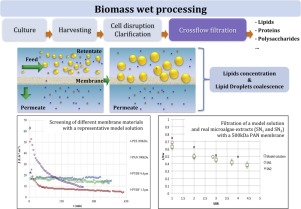当前位置:
X-MOL 学术
›
Process Biochem.
›
论文详情
Our official English website, www.x-mol.net, welcomes your
feedback! (Note: you will need to create a separate account there.)
Cross-flow filtration for the recovery of lipids from microalgae aqueous extracts: Membrane selection and performances
Process Biochemistry ( IF 3.7 ) Pub Date : 2020-02-01 , DOI: 10.1016/j.procbio.2019.10.016 Erika Clavijo Rivera , Liliana Villafaña-López , Shuli Liu , R. Vinoth Kumar , Michèle Viau , Patrick Bourseau , Cécile Monteux , Matthieu Frappart , Estelle Couallier
Process Biochemistry ( IF 3.7 ) Pub Date : 2020-02-01 , DOI: 10.1016/j.procbio.2019.10.016 Erika Clavijo Rivera , Liliana Villafaña-López , Shuli Liu , R. Vinoth Kumar , Michèle Viau , Patrick Bourseau , Cécile Monteux , Matthieu Frappart , Estelle Couallier

|
Abstract The biorefinery of microalgae necessitates innovative choices of soft and energy-efficient processes to guarantee the integrity of fragile molecules and develop eco-friendly production. A wet processing of biomass is proposed, which avoids expensive drying steps. It includes harvesting, cell disruption, and fractionation of the target compounds. Membrane filtration is a promising clean fractionation step. In this paper, the recovery of lipids from starving Parachlorella kessleri aqueous extracts by cross-flow filtration was studied. A model solution was formulated to test four membranes of different materials (PVDF, PES, PAN) and cut-offs (200 kDa – 1.5 μ m). The hydrophilic PAN 500 kDa membrane presented the best performance (flux stability, permeate flux, lipid retention, and cleanability) and was therfore selected for filtrating real aqueous extracts. Similar permeation fluxes were obtained with model and real products: 34–41 L h − 1 m − 2 respectively. The coalescence of lipid droplets was observed with model solutions but not with real products, less concentrated. The lipids from the real products were wholly retained by the PAN membrane, whereas some of the polysaccharides and proteins were able to permeate. An optimization of the coupling between culture, cell disruption, clarification, and filtration would allow a good concentration and purification of the lipids from microalgae.
中文翻译:

从微藻水提取物中回收脂质的错流过滤:膜选择和性能
摘要 微藻的生物精炼需要软和节能工艺的创新选择,以保证脆弱分子的完整性并发展生态友好型生产。提出了生物质的湿法加工,这避免了昂贵的干燥步骤。它包括目标化合物的收集、细胞破碎和分级分离。膜过滤是一个很有前途的清洁分馏步骤。在本文中,研究了通过错流过滤从饥饿的副绿藻水提取物中回收脂质。制定了一个模型溶液来测试四种不同材料(PVDF、PES、PAN)和截断值(200 kDa – 1.5 μ m)的膜。亲水性 PAN 500 kDa 膜表现出最佳性能(通量稳定性、渗透通量、脂质保留、和可清洁性),因此被选择用于过滤真正的水提取物。使用模型和实际产品获得了类似的渗透通量:分别为 34–41 L h - 1 m - 2。用模型溶液观察到脂滴的聚结,但不是用真正的产品,浓度较低。来自真实产品的脂质完全被 PAN 膜保留,而一些多糖和蛋白质能够渗透。培养、细胞破碎、澄清和过滤之间耦合的优化将允许从微藻中很好地浓缩和纯化脂质。来自真实产品的脂质完全被 PAN 膜保留,而一些多糖和蛋白质能够渗透。培养、细胞破碎、澄清和过滤之间耦合的优化将允许从微藻中很好地浓缩和纯化脂质。来自真实产品的脂质完全被 PAN 膜保留,而一些多糖和蛋白质能够渗透。培养、细胞破碎、澄清和过滤之间耦合的优化将允许从微藻中很好地浓缩和纯化脂质。
更新日期:2020-02-01
中文翻译:

从微藻水提取物中回收脂质的错流过滤:膜选择和性能
摘要 微藻的生物精炼需要软和节能工艺的创新选择,以保证脆弱分子的完整性并发展生态友好型生产。提出了生物质的湿法加工,这避免了昂贵的干燥步骤。它包括目标化合物的收集、细胞破碎和分级分离。膜过滤是一个很有前途的清洁分馏步骤。在本文中,研究了通过错流过滤从饥饿的副绿藻水提取物中回收脂质。制定了一个模型溶液来测试四种不同材料(PVDF、PES、PAN)和截断值(200 kDa – 1.5 μ m)的膜。亲水性 PAN 500 kDa 膜表现出最佳性能(通量稳定性、渗透通量、脂质保留、和可清洁性),因此被选择用于过滤真正的水提取物。使用模型和实际产品获得了类似的渗透通量:分别为 34–41 L h - 1 m - 2。用模型溶液观察到脂滴的聚结,但不是用真正的产品,浓度较低。来自真实产品的脂质完全被 PAN 膜保留,而一些多糖和蛋白质能够渗透。培养、细胞破碎、澄清和过滤之间耦合的优化将允许从微藻中很好地浓缩和纯化脂质。来自真实产品的脂质完全被 PAN 膜保留,而一些多糖和蛋白质能够渗透。培养、细胞破碎、澄清和过滤之间耦合的优化将允许从微藻中很好地浓缩和纯化脂质。来自真实产品的脂质完全被 PAN 膜保留,而一些多糖和蛋白质能够渗透。培养、细胞破碎、澄清和过滤之间耦合的优化将允许从微藻中很好地浓缩和纯化脂质。











































 京公网安备 11010802027423号
京公网安备 11010802027423号